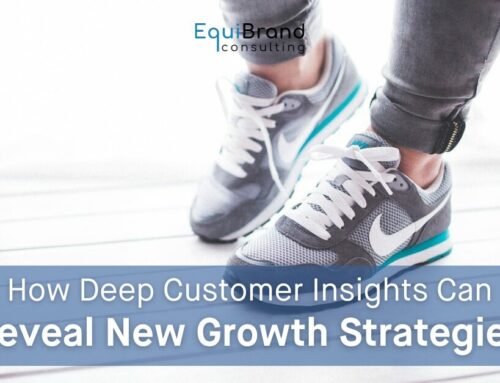What do you know about your important customers that your competitors don’t know?
This is the critical question we always ask in our consulting work at EquiBrand.
Here’s the reality: Collecting the same customer information, in the same way as your competitors just won’t cut it. Not in today’s world – and not in the future, either.
Look at business from a fresh perspective
 We used to consider this question hypothetically. Over time, we’ve found real value in having clients list, one by one, proprietary insights. The initial reaction is often blank stares, because many people have trouble putting pen to paper. Others admit they simply don’t know. More in-touch team members vigorously scribble or type in their answers.
We used to consider this question hypothetically. Over time, we’ve found real value in having clients list, one by one, proprietary insights. The initial reaction is often blank stares, because many people have trouble putting pen to paper. Others admit they simply don’t know. More in-touch team members vigorously scribble or type in their answers.
We then probe responses:
- Who are your most valuable customers?
- How do we define your competitive set?
- How do we make deep understanding actionable?
This insight is helpful because it guides the company to look at the business from a different perspective – through a different lens. Identifying and eliminating customer friction points is one of the surest ways to innovation success. This requires disproving common assumptions. The best way to do this is by asking different (and better) questions.
Market Research vs. Customer Obsession
Market research can lead to insight. But on its own, it is not insight. Many strong marketers dismiss traditional research. Despite the importance Steve Jobs placed on intuitive insight, he was proud Apple did little market research, saying,
“It’s really hard to design product by focus groups.
A lot of times, people don’t know what they want until you show it to them.”
Similarly, Starbucks’ Howard Schultz said succinctly, “I despise research. I think it’s a crutch.”
Jeff Bezos from Amazon has this perspective:
“Good inventors and designers deeply understand their customer.
They spend tremendous energy developing that intuition.
They study and understand many anecdotes rather than only the averages you’ll find on surveys.
They live with the design.
I’m not against beta testing or surveys. But you, the product or service owner, must understand the customer, have a vision, and love the offering. Then, beta testing and research can help you find your blind spots.
A remarkable customer experience starts with heart, intuition, curiosity, play, guts, taste.
You won’t find any of it in a survey.”
These business leaders obsess about customers and insight, but they disregard traditional market research.
Why is that? In our experience, many companies view market research in narrow terms as:
- A proxy for insight
- Anchored downstream
- something in the past…
Focus on the Whys to inspire action
Indeed, a lot of market research sees things through the rearview mirror:
- What happened yesterday?
- How did sales perform in Topeka compared with a year ago?
- How many social media likes did the latest blog post generate?
Not only that, a lot of existing data is descriptive regarding the whats and the hows: What are customers doing, and how have they behaved historically? This information does little to uncover growth opportunity areas.
Smart marketers know that the key is to immerse yourself in the customer experience, take a forward-looking windshield perspective, and focus on the whys. Your end goal should be clarity of thought that inspires action.
Change how you think about market research
“We didn’t learn anything new” is a statement we sometimes hear from clients, after conducting primary research interviews.
We respectfully indicate the question is not: “Did you hear anything new?”
It is: “Did you hear anything you’re not currently addressing?”
And, more importantly, “Why aren’t you addressing it?”
Bottom line: Don’t confuse market research with applied insight.
Looking for straightforward ways to grow your business to new levels? Learn more about customer insight and how upstream marketing can help you achieve your goals!
Download Chapter 2 of our book Upstream Marketing, FREE.


















Follow EquiBrand